Translate this page into:
Validity of mathematical proportions in maxillary anterior teeth among Bangladeshi population
Address for Correspondence: Dr. Monwarul Aziz, Department of Orthodontics and Dentofacial Orthopedics, Dhaka Dental College and Hospital, Mirpur - 14, Dhaka - 1216, Bangladesh. E-mail: monwar.dr@gmail.com
This article was originally published by Wolters Kluwer and was migrated to Scientific Scholar after the change of Publisher.
Abstract
Objective
To investigate the existence and suitability of mathematical proportions between the widths of maxillary anterior teeth in Bangladeshi population having an esthetic smile, with the aid of digital photographs and computer analysis.
Place of Study
The study was conducted at the Department of Orthodontics and Dentofacial Orthopedics of Dhaka Dental College and Hospital, Dhaka.
Period of Study
The study was conducted from April 2016 to September 2016.
Sample Selection
The study samples collected from Students of Dhaka Dental College, Mirpur-14, Dhaka, Bangladesh, with age limit 18–35 years.
Materials and Methods
Standardized frontal images of 100 dental students of Dhaka Dental College were captured. All the images were downloaded to a personal computer, and width of each tooth was measured by the scale tool of Photoshop CS version 8.0. All the data were analyzed (through standard statistical method) using Statistical Package for Social Science Software version 20 (IBM Corp., USA).
Results
The golden proportion existed in 17% of the perceived width ratios of lateral incisor to central incisor and 4% of the width ratios of canine to lateral incisor in natural dentition. Sixty-six percent lateral incisors are following the golden percentage, but only 7% central incisors and 21% canines are following the golden percentage. The recurring esthetic dental (RED) proportion existed in only 4% of participants.
Conclusions
The golden proportion, golden percentage, and the RED proportion cannot be used as constant proportions to create a harmonious proportion throughout the width of maxillary anterior teeth. The adjusted golden percentage might serve as a guideline to create harmonious proportions in maxillary anterior teeth for Bangladeshi population.
Keywords
Golden percentage
golden proportion
maxillary anterior teeth
recurring esthetic dental proportion
INTRODUCTION
Leonardo da Vinci said, “No human inquiry can be called science unless it pursues its path through mathematical exposition and demonstration.”[1] Maxillary anterior teeth are critical for esthetics on account of their high perceivability in an average open smile.[2] The most important components contributing to a pleasant smile are the size, shape, and arrangement of the maxillary anterior teeth.[3] The smile, obviously, uncovers the maxillary front teeth, and two aspects of proportional relationships are important components of their appearance: the tooth widths in relation to each other, and the height/width proportions of the individual teeth.[4]
Several authors have proposed the utilization of mathematic or geometric extents to depict the relationship between maxillary anterior teeth across the midline. These include golden proportion [Figure 1], golden percentage [Figure 2], and recurring esthetic dental (RED) proportion [Figure 3].

- Golden proportion to maxillary anterior teeth

- Golden percentage to maxillary anterior teeth

- Recurring esthetic dental proportion to maxillary anterior teeth
There is a relationship that exists connecting the beauty in nature and mathematics.[4] Lombardi[5] and Levin[6] were the pioneers to introduce the concept of golden proportion in dentistry and to transpose this ratio to the maxillary anterior sextant.[7] If we apply the golden proportion to maxillary anterior teeth, the viewing width of each tooth will be reduced by 62%, beginning with the central incisor, and proceeding posteriorly.[8]
Snow[9] put forward the golden percentage, in which the proportional width of each tooth should be: from right to left, canine 10%, lateral 15%, central 25%, central 25%, lateral 15%, and canine 10% of the total distance across the anterior segment, to get an esthetically pleasing smile.
However, Ward[10] explained RED proportion which states that the proportion of the successive width of the teeth as viewed from the front should remain constant as one moves distally. The RED proportion has been observed to be pleasing to the patients as well as clinicians and can be used to arrange the teeth in a pleasing smile.[11]
In today’s health and esthetic conscious world, the smile is an important component of an individual’s overall appearance and well-being.[12] Thus, a greater understanding of esthetic proportions is required.
The aim of this study is to evaluate the validity of various esthetic proportions that have been suggested in the literature to relate to the width of maxillary anterior teeth, in the Bangladeshi population, to establish a Bangladeshi norm.
MATERIALS AND METHODS
Study design and study population
A descriptive cross-sectional study was conducted from April 2016 to September 2016 in the Department of Orthodontics and Dentofacial Orthopedics, Dhaka Dental College and Hospital, Dhaka, Bangladesh.
The study population consisted of 100 dental students (male and female) of Dhaka Dental College, Dhaka.
Convenience sampling method was used.
Selection criteria
Inclusion criteria
The inclusion criteria were as follows:
Well-aligned anterior dentition with no overlapping, spacing, or crowding (Index of Orthodontic Treatment Need Grade 1)
Esthetically acceptable overbite and overjet
Patients willing to participate
Age range: 18–35 years
The participant and their parents should be Bangladeshi in origin.
Exclusion criteria
The exclusion criteria were as follows:
Midline diastema
Remarkable malformations, discolorations, and structural deformity of the teeth
Congenital or acquired facial and dental defects
History of orthodontic treatment
Restorations or trauma in maxillary anterior teeth
Periodontal disease.
Photographic standardization
In this study, we used a Sony Cyber-shot DSC-T2 (resolution: 8.00 megapixels, lens: Carl Zeiss Vario-Tessar ×3 zoom lens f = 6.33–19.0 mm [38–114 mm when converted to a 35 mm still camera] F3.5–4.3). The upper lip was retracted in all the photographs to clearly display maxillary anterior teeth as well as their respective gingiva. Lighting and distance (20 cm) was kept constant. In the sagittal plane, camera lens focus was centered with teeth midline. Transverse parallel plane was obtained by matching the horizontal lens grid with the intercanine plane.
Study procedure
A total number of 100 dental students (50 male and 50 female) of Dhaka Dental College in the age group 18–35 years were selected on the basis on inclusion and exclusion criteria. Ethical approval was obtained from the Ethical Committee of the Dhaka Dental College and Hospital (Ref. D.D.C/2016/1669).
A data collection sheet with necessary information for each participant was filled, and a photograph of maxillary anterior teeth was taken.
Measurements
Photoshop CS version 8.0 software was used for the required measurement of the photographs [Figure 4]. The mesiodistal width of the maxillary anterior teeth was measured from the photograph using the scale tool provided in the software. All the measurements were made by a single investigator to ensure reliability of results.
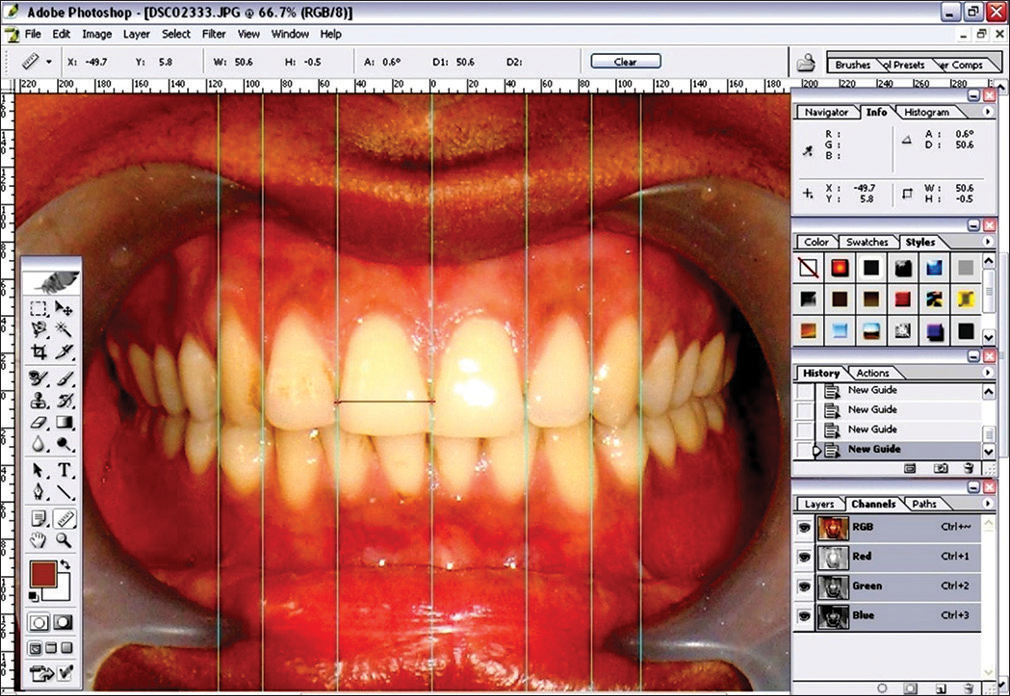
- Adobe Photoshop CS version 8.0 software was used to measure the mesiodistal width of maxillary anterior teeth
For this study, the golden proportion was taken as 62%. Therefore, for estimation of the existence of golden proportion, the measured width of the central incisor was multiplied by 62% and compared with that of the adjacent lateral incisor. Similar values indicated that the width of the central incisor was in golden proportion to the width of the lateral incisor. Similarly, by comparing the width of the lateral incisor after multiplying by 62% with that of the canine, it was determined whether the width of the lateral incisor is in golden proportion in relation to the width of the canine [Figure 1].
The golden percentage was calculated by dividing the width of each central incisor, lateral incisor, and canine by the total width of all six maxillary anterior teeth and multiplying the resulting value by 100. If the resulting width of the canines, lateral incisors, and central incisors showed 10%, 15%, and 25%, respectively, of the intercanine distance, they were taken as following golden percentage [Figure 2].
For RED proportion, ratio of the width of lateral incisor and central incisor was compared to that of canine and lateral incisor. Constant values indicate existence of RED proportion [Figure 3].
Data analysis
The measured width of maxillary anterior teeth was entered in an Excel Sheet and then the data were transferred to Statistical Package for Social Science Software version 20 (IBM Corp., USA) for analysis. Paired-samples t-test was used to compare differences in the mean of widths. Ninety-five percent confidence intervals about the mean were constructed for differences. Level of significance was set at 0.05.
RESULTS
The study group consisted of 100 participants, of which 50 (50%) were males and 50 (50%) were females. The mean age was found to be 20.4 years.
Paired-samples t-test in all population revealed statistically significant differences in perceived widths of maxillary anterior teeth except between the left and right canines. However, the data also revealed no existence of a statistically significant difference between the widths of the left and right centrals, the left and right laterals, and the left and right canines in females. However, in males, except in the left and right canines, there were significant differences in perceived widths of maxillary anterior teeth [Table 1].
| All participants (male and female) | n | Mean±SD | SEM | t | P |
|---|---|---|---|---|---|
| Central | |||||
| Left | 100 | 53.5500±3.83070 | 0.38307 | −4.971 | 0.000 |
| Right | 54.0900±3.97999 | 0.39800 | |||
| Lateral | |||||
| Left | 36.0900±3.72839 | 0.37284 | −3.909 | 0.000 | |
| Right | 36.8650±3.52828 | 0.35283 | |||
| Canine | |||||
| Left | 28.2000±3.56753 | 0.35675 | −2.048 | 0.043 | |
| Right | 28.6550±3.60464 | 0.36046 |
SD – Standard deviation; SEM – Standard error of mean
The data of all participants revealed that 17% have the width of their left central incisors in golden proportion to the width of their left lateral incisors and 18% have the width of their right central incisors in golden proportion to the width of their right lateral incisors. However, only 4% have the widths of their left lateral incisors in golden proportion to the widths of their left canines, and 8% have the widths of their right lateral incisors in golden proportion to the widths of their right canines. Hence, 17% have their central incisors in golden proportion to the width of their lateral incisors, and 4% have their lateral incisors in golden proportion to the widths of their canines [Table 2 and Figure 5].
| Mean | Mean differences | SD | SEM | P | |
|---|---|---|---|---|---|
| Left | |||||
| Central × 62% | 33.2010 | 2.88900 | 2.37503 | 0.23750 | 0.000 |
| Lateral | 36.0900 | 3.72839 | 0.37284 | ||
| Lateral × 62% | 22.3758 | 5.82420 | 2.31160 | 0.23116 | 0.000 |
| Canine | 28.2000 | 3.56753 | 0.35675 | ||
| Right | |||||
| Central × 62% | 33.5358 | 3.32920 | 2.46759 | 0.24676 | 0.000 |
| Lateral | 36.8650 | 3.52828 | 0.35283 | ||
| Lateral × 62% | 22.8563 | 5.79870 | 2.18753 | 0.21875 | 0.000 |
| Canine | 28.6550 | 3.60463 | 0.36046 |
SD – Standard deviation; SEM – Standard error of mean
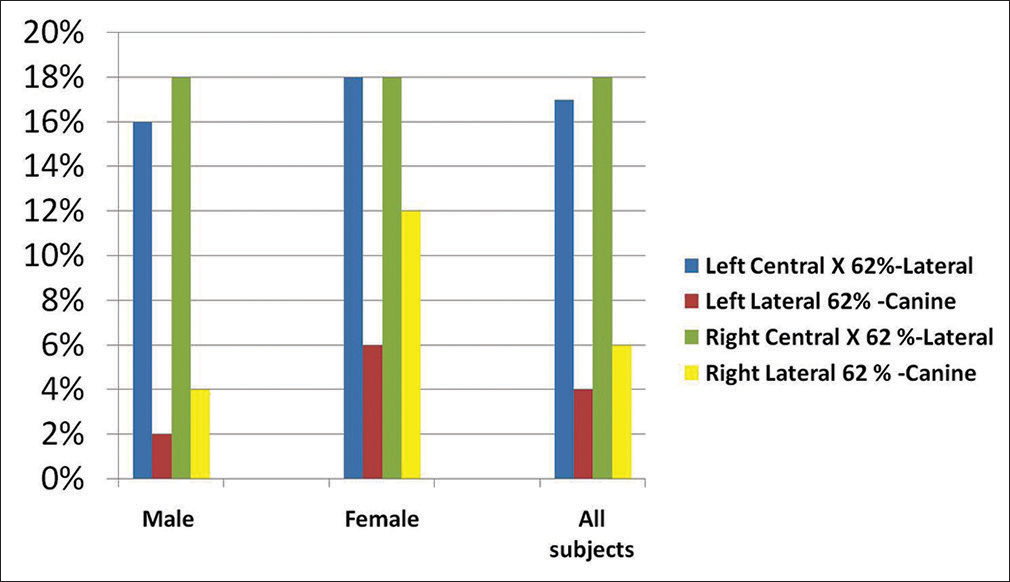
- The frequency of golden proportions in all participants
The data also discovered 16% of males and 18% of females have the widths of their left central incisors in golden proportion to the width of their left lateral incisors. However, 18% of both male and female participants have the widths of their right central incisors in golden proportion to the width of their right lateral incisors. Hence, 17% of males and 18% of females have the widths of their central incisors in golden proportion to the width of their lateral incisors [Table 2 and Figure 5].
Moreover, the data show that 2% of male and 6% of female participants have the widths of their left lateral incisors in golden proportion to the widths of their left canines, and 4% of male and 12% female participants have the widths of their right lateral incisors in golden proportion to the widths of their right canines. Hence, 2% of male and 6% of female participants have the widths of their lateral incisors in golden proportion to the widths of their canines [Table 2 and Figure 5]. In our study, we found 66% lateral incisors were following the golden percentage, but only 7% central incisors and 21% canines were following the golden percentage [Table 3 and Figures 6-9].
| Left | Right | |||||
|---|---|---|---|---|---|---|
| Central | Lateral | Canine | Central | Lateral | Canine | |
| n | 100 | 100 | 100 | 100 | 100 | 100 |
| Minimum (%) | 20.95 | 12.17 | 8.62 | 20.55 | 12.30 | 8.62 |
| Maximum (%) | 25.00 | 18.07 | 15.52 | 25.00 | 17.87 | 15.57 |
| Mean (%) | 22.7854 | 15.5220 | 12.0634 | 22.5608 | 15.1907 | 11.8776 |
| SD | 0.87670 | 1.01992 | 1.23044 | 0.86244 | 1.08367 | 1.27740 |
| SEM | 0.08767 | 0.10199 | 0.12304 | 0.08624 | 0.10837 | 0.12774 |
| P | 0.000 | 0.000 | 0.000 | 0.000 | 0.000 | 0.000 |
SD – Standard deviation; SEM – Standard error of mean

- The relationship between the suggested golden percentage and that found in this study for all participants
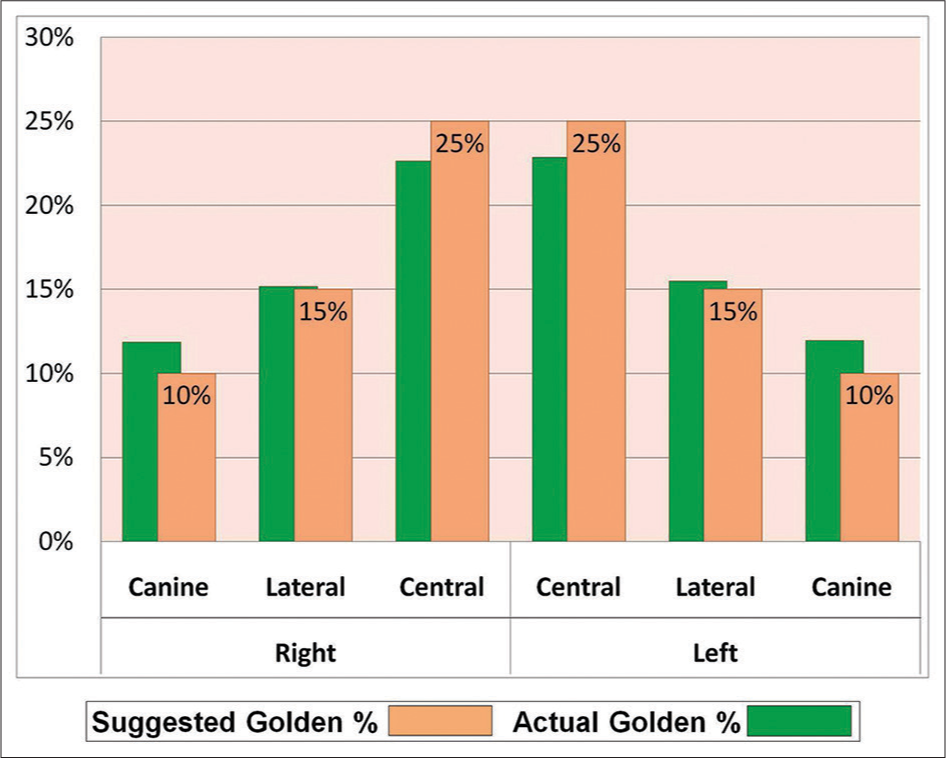
- The relationship between the suggested golden percentage and that found in this study for male participants

- The relationship between the suggested golden percentage and that found in this study for female participants
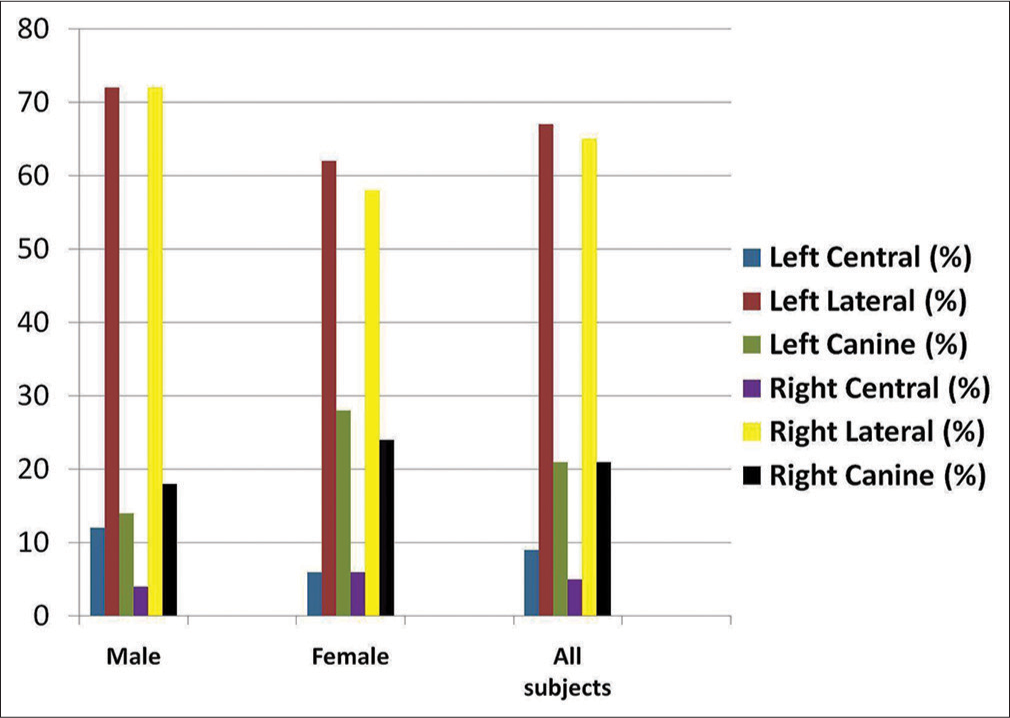
- The frequency of golden percentage in all participants
This study revealed that only 4% of maxillary anterior teeth were following the RED proportions [Table 4 and Figure 10].
| Left | Right | |||||
|---|---|---|---|---|---|---|
| Lateral/central | Canine/lateral | Lateral/central | Canine/lateral | |||
| n | 100 | 100 | 100 | 100 | ||
| Minimum (%) | 54.55 | 51.28 | 50.00 | 51.28 | ||
| Maximum (%) | 80.77 | 126.67 | 81.13 | 111.76 | ||
| Mean (%) | 67.4562 | 79.0141 | 68.2525 | 78.3650 | ||
| Mean differences (%) | 11.55786 | 10.11250 | ||||
| SD | 5.76341 | 13.32069 | 5.55136 | 11.80053 | ||
| SEM | 0.57634 | 1.33207 | 0.55514 | 1.18005 | ||
| P | 0.000 | 0.000 | ||||
SD – Standard deviation; SEM – Standard error of mean
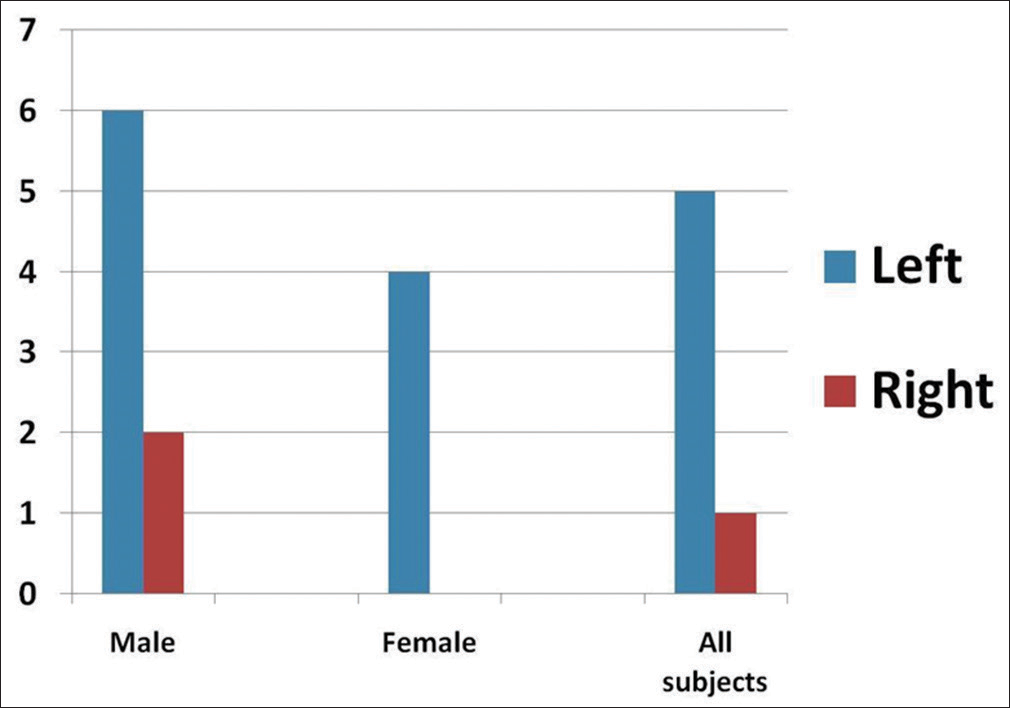
- The frequency of recurring esthetic dental proportion in all participants
DISCUSSION
The study was carried out to discover the existence of a mathematical proportion between the maxillary anterior teeth widths which are the main teeth visible in a smile obtained using standardized[13] frontal photographs.
The sample was representative of a Bangladeshi population that is dental students from Dhaka Dental College. The size and shape of the maxillary anterior teeth, especially when perceived from front, have considerable implications for esthetics in diagnosis and treatment planning.
According to Preston,[14] golden proportion is in the range of 0.61–0.63, and the same range was considered in this study during evaluation of the data. In the present study, golden proportion between maxillary central and lateral incisor was found in 16% in males and 18% in females; the golden proportion between maxillary lateral incisor and canine was found 2% in males and 6% in females. Similar results were found by Ali Fayyad et al.[7] (in their study on Arabic participants, they found 31.3% of males and 27.1% of females have golden proportion among width of central incisor to the width of the lateral incisor, and 13.1% of males and 11.8% of females have the widths of their lateral incisor in golden proportion to the width of their canine), Preston[14] (in California, USA; 17% between central and lateral incisor and 0% between lateral incisor and canine), Mahshid et al.[15] (in Tehran, Iran; 34.1% between central and lateral incisor and <10% between lateral incisor and canine), Azam et al.[8] (in Islamabad, Pakistan; golden proportion was found to be 10% of the perceived lateral to central incisor ratio on both sides and 2% of the perceived canine to lateral incisor ratio on the right side and 6% on the left side), Sulaiman et al.[16] (on Malaya population; 19% have the width of their right central incisors in golden proportion to the width of their right lateral incisors. 17% of the participants had the width of their right lateral incisors in golden proportion to the width of their right canines), Alhabahbah et al.[17] (in Amman, Jordan; 18.6% of males and 23.4% of females have the widths of their right central incisors in golden proportion to the width of their right lateral incisors. 9.7% of male and 10.5% of female participants have the widths of their right lateral incisors in golden proportion to the widths of their right canines. 20.4% of the male and 25.1% of the female participants have the widths of their left central incisors in golden proportion to the widths of the left lateral incisors, and 11.5% of males and 12.4% of females have the widths of the left lateral incisors in golden proportion to the widths of their left canines), Meshramkar et al.[18] (on European population; golden proportion in 3.9% of individuals between central and lateral incisor and in 0.6% of individuals between lateral incisor and canine), Sandeep et al.[19] (in Andhra Pradesh, South India; golden proportion between maxillary central and lateral incisor was 25% in males and 17.5% in females; the golden proportion between maxillary lateral incisor and canine was 5% in males and 10% in females), and Agrawal et al.[20] (on Indian population; 3.75% of left central incisor in golden proportion to left lateral incisor, left lateral incisor in golden proportion to left canine, and central incisor in golden proportion to right lateral incisor. 6.25% of right lateral incisor in golden proportion to right canine) [Figure 11]. However, the universal use of the golden proportion should no longer be considered since various articles have found that the golden proportion was not observed in a majority of observed natural smiles.[3,7,8,15,16,19-23]
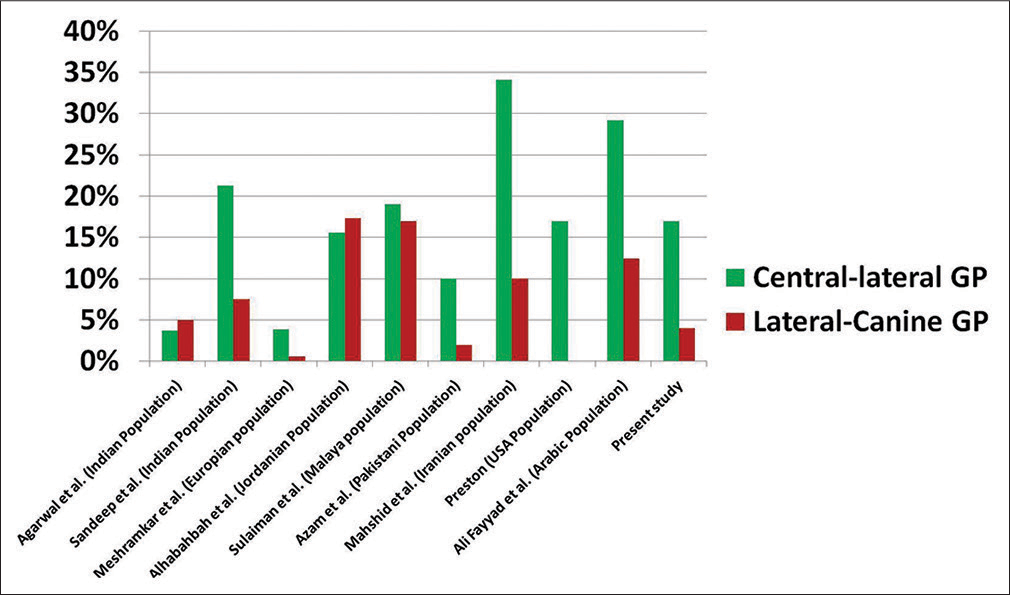
- Relation of golden proportions observed in different studies
For implementing the golden percentage theory, the result of the present investigation suggests that the mean value for a golden percentage for central incisors is 22.67% ± 0.1588. These figures are lower than those suggested by Snow[9] who estimated a value of 25% for central incisors. However, the mean values of golden percentage for lateral incisors are 15.36% ± 0.2342. These figures can be considered to be in agreement with those suggested by Snow[9] who recommended a value of 15% as the golden percentage for lateral incisors. With respect to the golden percentage of canines, the results of this study showed mean values of 11.97% ± 0.1314. These figures are higher than those suggested by Snow[9] who recommended a golden percentage value of 10% for canines but are comparable to that suggested by Murthy and Ramani,[11] i.e., 22% for centrals, 15.5% for laterals, and 12.5% for canines. Furthermore, a recent study conducted by Markovics et al.[21] showed that golden proportion is not applicable in natural dentition. Based on our variable results, golden percentage also does not seem to exist.
Ward[10] in a web-based study was the first to consider the importance of RED proportion for determining the width of maxillary anterior teeth. Murthy and Ramani[11] reported that the RED proportion did not exist between the widths of the maxillary anterior teeth, and this was substantiated by Hasanreisoglu et al.,[3] Rosenstiel et al.,[23] and Shetty et al.[24] With respect to RED proportion, the results of this investigation showed that the ratio of the width of maxillary lateral incisors to the width of central incisors is 67.85% ± 0.56. The ratio of the width of canine to the width of lateral incisor is 78.69% ± 0.45. In this study, the ratio between central and lateral incisors and between lateral incisors and canine is not constant. The ratio increases as one moves distally. The results of RED proportion obtained were similar to that obtained in the study done by Murthy and Ramani[11] (RED proportion between central incisor and lateral incisor is 69.50%–70.33%, and RED proportion between canine and lateral incisor is 80%–83% range) and Shetty et al.[24] (lateral incisor to central incisor width ratio for “small” category teeth is 73%, for “medium” teeth is 72%, and for “tall” teeth was 71%, and canine to lateral incisor width ratio for “small” category teeth is 76%, for “medium” teeth is 83%, and for “tall” teeth was 75%). Hence, there is no evidence in this study to support the RED proportion theory as applied to natural dentition.
Of all the esthetic proportions that have been proposed to relate the width of maxillary anterior teeth, golden percentage theory has been recommended by many studies if the percentages are adjusted taking into consideration the ethnicity of the population.[7,8,11,16] Therefore, the values that we have calculated for the golden percentage might serve as a guideline to create harmonious proportions in maxillary anterior teeth for Bangladeshi population. It is additionally proposed that neither of the extents can be taken as a sole paradigm to decide the width of maxillary anterior teeth and modifications should be done according to age, sex, ethnicity, personality, and profession of the individual.[22]
CONCLUSIONS
Keeping in mind the end goal to set up independently methodical width proportion between maxillary anterior teeth, ethnic differences should be considered to determine exactly what percentages are truly golden. The adapted golden percentage might serve as a guideline to create well-balanced proportions in maxillary anterior teeth for Bangladeshi population.
Financial support and sponsorship
Nil.
Conflicts of interest
There are no conflicts of interest.
References
- Quotations by Leonardo da Vinci. JOC/EFR December 2013. Available from: http://wwwhistory.mcs.standrews.ac.uk/Quotations/Leonardo.html. [Last cited on 2016 Oct 05]
- [Google Scholar]
- Peer assessment of dental attractiveness. Am J Orthod Dentofacial Orthop. 2006;130:163-9.
- [CrossRef] [PubMed] [Google Scholar]
- An analysis of maxillary anterior teeth: Facial and dental proportions. J Prosthet Dent. 2005;94:530-8.
- [CrossRef] [Google Scholar]
- Proffit WR, Fields HW, Sarver DM, Ackerman JL, eds. Contemporary Orthodontics. Missouri: Elsevier Inc.; 2013. p. :172-3.
- The principles of visual perception and their clinical application to denture esthetics. J Prosthet Dent. 1973;29:358-82.
- [CrossRef] [Google Scholar]
- Geometric and mathematical proportions and their relations to maxillary anterior teeth. J Contemp Dent Pract. 2006;7:62-70.
- [Google Scholar]
- Esthetic smile analysis of maxillary anterior tooth width: The golden percentage. J Esthet Dent. 1999;11:177-84.
- [CrossRef] [Google Scholar]
- Proportional smile design using the recurring esthetic dental (red) proportion. Dent Clin North Am. 2001;45:143-54.
- [Google Scholar]
- Evaluation of natural smile: Golden proportion, RED or Golden percentage. J Conserv Dent. 2008;11:16-21.
- [CrossRef] [PubMed] [Google Scholar]
- Cosmetic dentistry-esthetic dentistry and the golden proportion. Oral Health. 2004;94:51-61.
- [CrossRef] [PubMed] [Google Scholar]
- Evaluation of “golden proportion” in individuals with an esthetic smile. J Esthet Restor Dent. 2004;16:185-92.
- [Google Scholar]
- Existence of golden proportion in maxillary anterior teeth of University of Malaya dental students. Ann Dent Univ Malaya. 2010;17:9-14.
- [Google Scholar]
- Evaluating the validity of mathematical proportions in maxillary anterior teeth in Jordanian population. Pak Oral Dent J. 2016;36:295-300.
- [Google Scholar]
- A study to evaluate the prevalence of golden proportion and RED proportion in aesthetically pleasing smiles. Eur J Prosthodont Restor Dent. 2013;21:29-33.
- [Google Scholar]
- An analysis of maxillary anterior teeth dimensions for the existence of golden proportion: Clinical study. J Int Oral Health. 2015;7:18-21.
- [Google Scholar]
- Comparative photographic evaluation of various geometric and mathematical proportions of maxillary anterior teeth: A clinical study. Indian J Dent Res. 2016;27:32-6.
- [CrossRef] [Google Scholar]
- Aesthetic principles of the upper front teeth: Application of golden proportion (Levin) and golden percentage (Snow) Acta Med Marisiensis. 2013;59:25-7.
- [Google Scholar]
- Evaluating Recurring Esthetic Dental Proportion (RED) and Golden Proportion in Natural Dentition. 2016. Avicenna Journal of Dental Research. Available from: http://avicennajdr.com/?page=article&article_id=30267. [Last cited on 2016 Jun 12]
- [Google Scholar]
- Dentists’ preferences of anterior tooth proportion – A web-based study. J Prosthodont. 2000;9:123-36.
- [Google Scholar]
- To evaluate the validity of recurring esthetic dental proportion in natural dentition. J Conserv Dent. 2011;14:314-7.
- [CrossRef] [PubMed] [Google Scholar]






